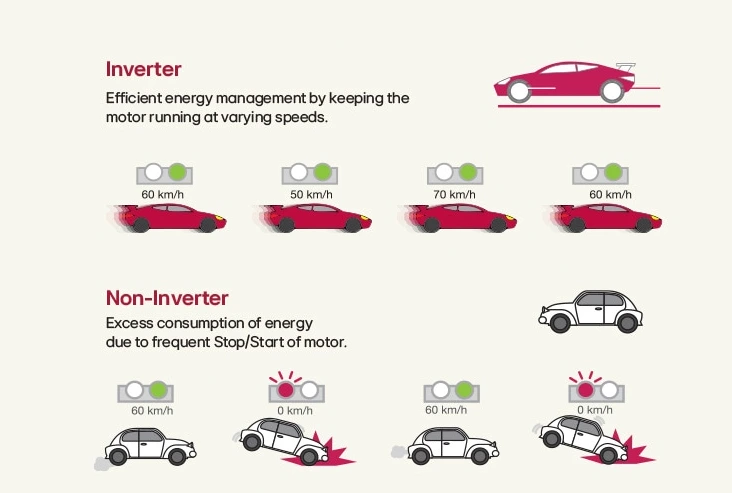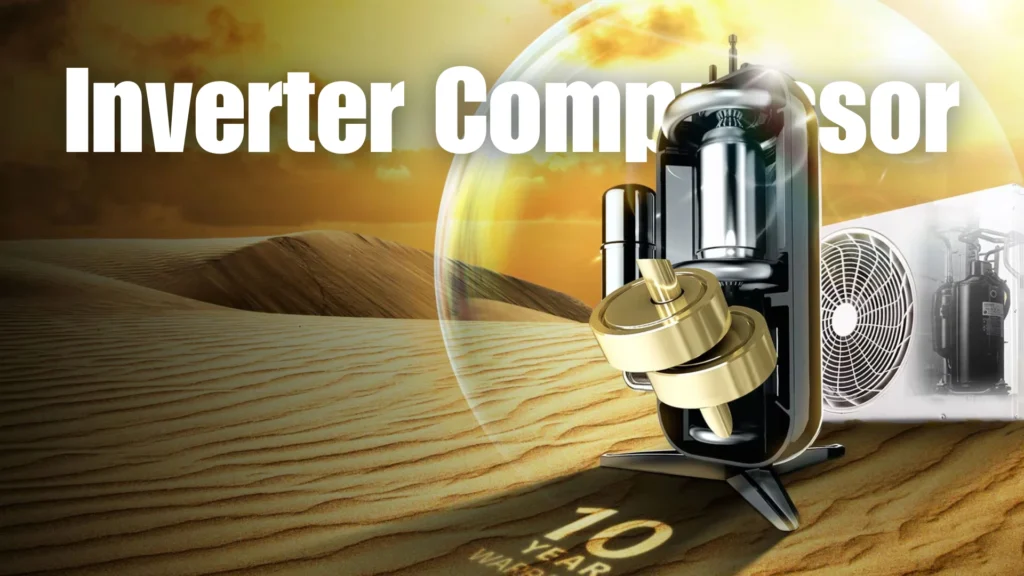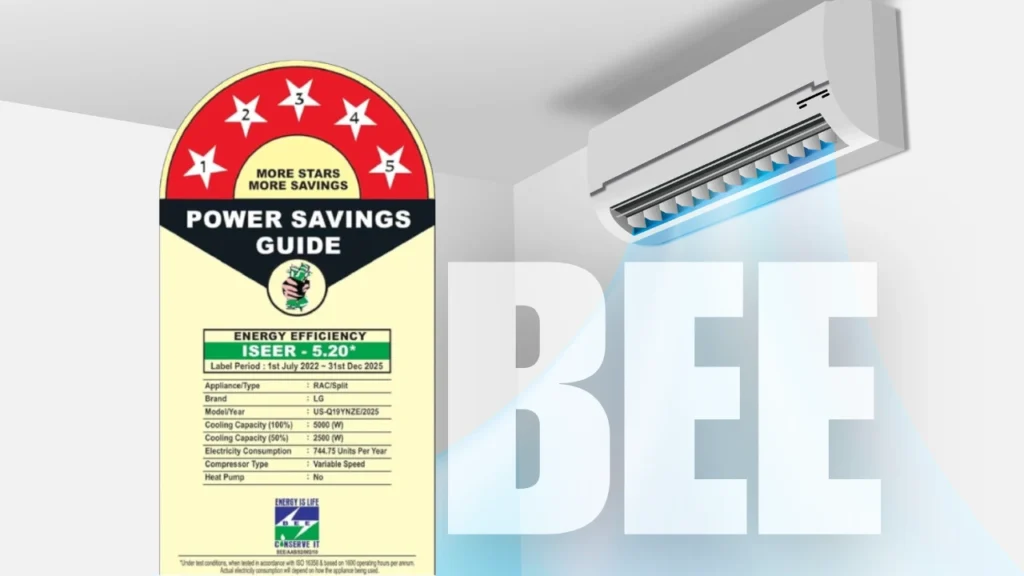If you are thinking of buying an air conditioner, the latest and the most efficient technology that is available in market today is the Inverter Technology for AC. Inverter technology is designed in such a way that it can save 30-50% of electricity (units consumed) over a regular air conditioner. And since 2016, BEE has started give star ratings to inverter technology AC as well. And in 2018 BEE has merged the star rating levels of inverter and non inverter ACs.
However, let’s look at what is inverter technology and how is it different from a non inverter ACs.
How does an air conditioner work?
For most people, air conditioner just throws cool air at the temperature one sets it at. But does it really work that way? In fact air conditioner during cooling process, takes the indoor air, cools it by passing it through evaporator and throws it back in the room. It is quite opposite to how our good old air coolers used to work.

Air coolers used to take outside air, cool it with water and throw it in. But air conditioners just work on internal air. Along with evaporator air conditioner also has a compressor that compresses the gas (refrigerant) in the AC to cool it that in turn cools the incoming internal air from the room.
In a regular air conditioner the compressor is either off or on. When it is on, it works at full capacity and consumes full electricity it is designed to consume. When the thermostat reaches the temperature level set in the AC, the compressor stops and the fan (in AC) continues to operate. When the thermostat senses that the temperature has increased, the compressor starts again.
What is Inverter Air Conditioner?
The inverter technology works like an accelerator in a car. When compressor needs more power, it gives it more power. When it needs less power, it gives less power. With this technology, the compressor is always on, but draws less power or more power depending on the temperature of the incoming air and the level set in the thermostat.

The speed and power of the compressor is adjusted appropriately. This technology was developed in Japan and is being used there successfully for air conditioners and refrigerators. This technology is currently available only in split air conditioners.
What is benefit of Inverter Technology?
Every air conditioner is designed for a maximum peak load. So a 1.5 ton AC is designed for a certain size of room and 1 ton for a different size. But not all rooms are of same size. A regular air conditioner of 1.5ton capacity will always run at peak power requirement when the compressor is running.
An air conditioner with inverter technology will run continuously but will draw only that much power that is required to keep the temperature stable at the level desired. So it kind of automatically adjusts its capacity based on the requirement of the room it is cooling. Thus drawing much less power and consuming lesser units of electricity.

Although air conditioner with Inverter Technology adjusts its capacity based on the room requirement, it is very important to install a right sized air conditioner in a room. Please make sure that you evaluate the room and air conditioner capacity before you make a purchase.
Difference between Inverter Technology AC and BEE 5 star non inverter AC?
- Inverter technology air conditioners are variable speed/ variable tonnage air conditioners and thus operationally they are quite different from regular air conditioners that have single speed compressors and single tonnage.
- Inverter technology air conditioners adjust their speed/tonnage depending on heat load of a room. Whereas regular air conditioners do not.
- Every room has a different heat load, even if they are of the same size. To give you an analogy, every human being is different; even then the waist sizes of most trousers available in the market are fixed (leaving the ones with elastic). Inverter Technology AC is just like a trouser with an elastic waist that can adjust to the size. The other benefit is that even if the waist size increases or decreases, the trouser with elastic will adjust accordingly. Regular Air Conditioners are fixed size.
- The heat load in a room does not remain constant and it varies from seasons, varies based on number of people, varies between day and night, varies based on climate profiles of your location. To take the same analogy we mentioned above, the waist size increases or decreases with the amount of food one eats or the amount of exercise one does. So as a trouser with elastic waist can work well, an air conditioner with inverter tech can work well.
Inverter AC vs Non Inverter AC | Power Consumption
Here is a comparison of 3 Star Daikin Non-Inverter AC With 3 Star Daikin Inverter AC.
| Feature | Daikin (Non-Inverter) | Daikin (Inverter) |
|---|---|---|
| ISEER Rating | 3.95 | 4.00 (Better) |
| Annual Power Usage | 989.31 kWh | 966.47 kWh (Lower) |
| Cooling Capacity (100%) | 5050 W | 5000 W |
| Cooling Capacity (50%) | Not Available | 2500 W (Energy-efficient partial load operation) |
| Compressor Type | Single Stage | Variable Speed (Inverter) (More efficient) |
| Heat Pump | No | No |
Here is a comparison of Daikin 3 Star Non-Inverter AC with LG 5 Star Inverter AC
| Feature | Daikin Non-Inverter AC | LG 5-Star Dual Inverter AC |
|---|---|---|
| ISEER Rating | 3.95 | 5.20 ✅ (Higher efficiency) |
| Annual Power Usage | 989.31 kWh | 744.15 kWh ✅ (Consumes less electricity) |
| Cooling Capacity (100%) | 5050 W | 5000 W |
| Cooling Capacity (50%) | Not Available | 2500 W ✅ (More efficient at partial load) |
| Compressor Type | Single Stage (Fixed Speed) | Variable Speed (Dual Inverter) ✅ |
The LG 5 Star Inverter is priced ₹10,000 higher than the Daikin non-Inverter AC. But if you use the AC for 8 months in a year, you can easily recover that 10K investment within a year or 2. you can use our AC monthly bill calculator to find accurate values.

Are Inverter technology Air Conditioners slow in cooling?
Several people have concerns that Inverter Technology air conditioners do not cool well or cool slowly. However let us take this image as reference to understand how inverter AC works:

Non inverter ACs are fixed speed ACs, where as inverter ACs are variable speed ACs. Non inverter ACs have compressors that go “On” and “Off”. Whereas inverter ACs have compressors that are “On” all the time. As non inverter ACs are sized for peak summer heat load, they are over-sized all the other times (in fact most of the time people oversize even for peak summer season).
The drawback of the same is that the AC “Over cools” most of the time. So if you set AC at temperature of 25, it will cool it down to 23 or 22. Now one would question: then what is the use of thermostat? Well the thermostat (in a non inverter AC) switches off the compressor when the outside temperature has reached 25. But a lot has happened before that. In an AC, refrigerant moves from liquid to gas (by taking heat from the room) and then back from gas to liquid as the compressor compresses it. But if the refrigerant is more and heat in the room is less (which happens in over sized AC), it does not get enough heat from the room to convert from liquid to gas and it keeps moving as liquid.
Now when the thermostat detects temperature and switches off the compressor, the refrigerant still remains in liquid state and thus has capacity to take heat from room to convert to gas. And so it takes more heat from the room and cools the room below the set temperature.
In comparison, the inverter tech AC changes the flow rate of refrigerant based on the heat of the room. When heat is less, the flow rate is less, when heat is more, the flow rate is more. And it does not switch off the compressor ever. It just makes sure that if temperature setting is 25, it is maintained at that level.
So the difference is: non inverter AC would over cool as shown in the picture. Whereas inverter AC will cool optimum. And thus one may feel that inverter AC does not cool or is slow.
All the Latest Inverter ACs have Powerful Cooling Modes like Himalayan Cooling, Jet Cool, Viraat Mode that can deliver Instant Cooling within a few minutes by working at 120% Capacity.
Are there Star Ratings for Inverter ACs?

In 2016, BEE introduced a new star rating standard for Inverter Technology ACs as well. In 2018 all inverter AC models are in BEE 3, 4 and 5 Star rating ranges on BEE.
Inverter AC vs Non Inverter AC Price Difference
If you are purchasing an inverter AC in 2025, the pricing is the same as a non-inverter AC. Previously, inverter ACs were priced slightly higher, but in 2025, non-inverter ACs have become obsolete. You can now get a 1.5 Ton 3 Star Inverter AC for ₹35,000 from top brands like Lloyd, Daikin, and others.
